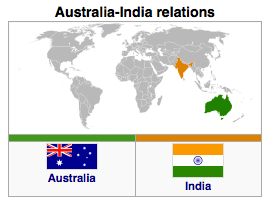India And Australia Inch Towards Strategic Partnership – Analysis
By SAAG
By Rajeev Sharma
For many years, India and Australia have not been as close as they should have been. The China factor has by and large been responsible for this relative chill in Indo-Australian bilateral relations. This is despite a large number of commonalities between the two. Both are strong, vibrant, secular,multi-cultural democracies. Both have free press and independent judicial system, with English language as an important link. Cricket is another important linkage between the two as the game is a raging passion among the people of the two countries. Their bilateral trade has already crossed asignificant $ 20 billion mark and is set to zoom further. Almost half a millionIndians live in Australia and this Southeast Asian and Pacific power is a popular destination for Indian students and tourists alike.

Australia is in India’s extended neighbourhood, a point made bySteven Smith, then Australian Foreign Minister and currently the Defence Minister, when he made a key note address in September 2008 at the University of Western Australia. Smith said: “It is under-appreciated thatPerth and Chennai are closer to each other than Sydney is to Seoul, to Shanghai, or to Tokyo… As the world sees the potential of an Asian/Pacific century unfold, Australia sees India at the heart of this historic shift inpolitical and economic influence.”
Smith was not wrong. The commercial ties between India and Australia date back to the 18th century when India played a pivotal role in nourishing the young colony and trade with Australia came to bean important element in the operations of the East India Company in Bengal. At that period Australia’s most immediate and direct links were with India rather than the United Kingdom – and this state of close contacts remained for half acentury. Since then, for over a hundred years India and Australia continued to be afar with each other – diplomatically and strategically.
Despite their stark commonalities and vibrant trade and economicties, the two countries remained rather cool to each other’s strategic needs.The biggest irritant in Indo-Australian bilateral relations, from the Indian perspective, was Canberra’s steadfast refusal to sell uranium to New Delhi – a decision which has just been reversed. The two important regional powers, with impressive military power, in a way, started re-discovering each other abouttwo years ago. The turning point came in November 2009 when the then Australian Prime Minister Kevin Rudd visited India and during his official talks with Prime Minister Manmohan Singh, the two powers decided to elevatetheir relationship to a level of strategic partnership.
Since then the two nations have slowly but steadily inched closer to each other. India is strengthening its strategic partnership with Australia, the world’s smallest continent but sixth-largest country two and half timesbigger than India. The two countries have decided to step up their defencecooperation progressively, a development which will keep the Chinese strategicestablishment on its edge. The growing proximity between the two countries became evident on December 7 when the visiting Australian Defence MinisterSteven Smith held talks in New Delhi with his Indian counterpart AK Antony and the two sides agreed to inject new vigour in their defence cooperation. Smith’s India visit came days after Australia’s ruling Labour Party decided on December4 to sell uranium to India for power generation. Australia is an important Asia-Pacific power which has very close bilateral ties with China and is a major uranium supplier to Beijing.
During the two defence ministers’ talks, Antony and Smith agreed to institute Track 1.5 Dialogues (semi-government level) on defence matters between suitable institutions of both sides. Significantly, the defence ministers stressed on freedom of navigation is international waters. The issue assumes significance as China has upped its ante on South China Sea which Beijing has for quite some time been projecting as its exclusive preserve and wants international navies to keep off from these international waters. India, lik emost other countries, has refused to toe the Chinese line in this regard. The Indian and Australian defence ministers discussed at length the regional security issues, threats of piracy. The two sides also agreed to continue with the practice of the respective Navies conducting Passage Exercises (PASSEX) during naval ship visits to each other’s ports. Antony and Smith also agreed toexamine the possibility of undertaking a full-fledged bilateral Naval Exercise in the future.
The importance of Australia as a major regional power and an influential player in international affairs cannot be undermined. China has sofar successfully managed to keep Australia away from such powers as India and Japan and torpedoes their plans aimed at forming a lose consortium of Australia, India, Japan and the United States – an idea that germinated half adecade back as the Quadrilateral Initiative but fizzled out. Diplomatic observers believe that it was China that aborted the Quad Initiative by weaning Australia away from the proposed strategic forum. Now that India-Australia bilateral ties are on an upswing and are gradually acquiring overtones of a strategic partnership, the Chinese approach will be interesting to watch.
A trilateral dialogue involving India, Japan and the United Statesis slated for a kick off later this month.
Australia will do well to join thisdialogue in a couple of years’ time by which time the Indo-Australian ties would have become more vibrant. If that were to happen, it will be the rebirth of the Quad Initiative.
The writer is a NewDelhi-based strategic analyst and journalist-author. He can be reached [email protected].
